Rediscovering Pettah’s old world charm
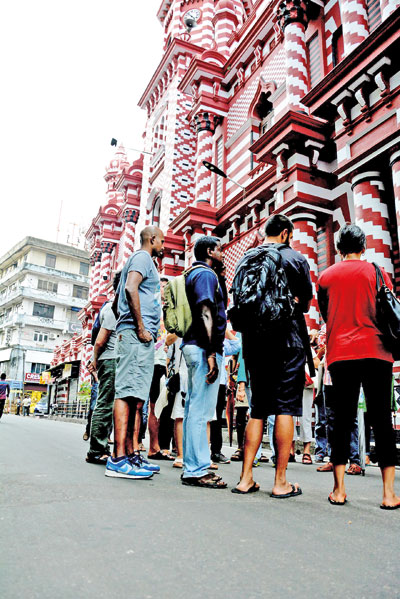 The age –old structures in Pettah — most of which have been kept and renovated to represent their truest forms, treasure stories and memories of the ghosts of the past while many live on building today.
The age –old structures in Pettah — most of which have been kept and renovated to represent their truest forms, treasure stories and memories of the ghosts of the past while many live on building today.On a balmy Sunday evening, an enthusiastic band of 26 excursionists huddled together search for something beyond what lies on the surface of Pettah’s busy streets.
‘Diversity Walks’ organized by the GIZ were inspired by walking tours held in Germany. These guided walks give the opportunity for people to learn about questioned histories that one lives in. By initiating these walks GIZ hopes that they will enable dialogue within communities, facilitating an understanding of its complexities and opportunities of coexistence.
Almost like stepping into a time portal we are warmly introduced to Old Ceylon with the pungent smells of vegetables (mainly onions), the hustle and bustle of vehicles.
Our guide for this excursion Dr. Asoka Mendis De Zoysa, Professor of German Studies at the Department of Modern Languages and coordinator of the project “Samkathana” at the Faculty of Humanities, University of Kelaniya, helped open eyes of walking tour participants to the colonial history and transitions of Pettah from the emergence of South Indian traders to the current state of its diverse modern commercial occupants.
This multi-ethnic labyrinth that is Pettah is dimmed down on Sunday evening with only a small clamor of noise as we were approached by loud road-side vendors selling knick-knacks from headbands, cloth, sequins, questionable antiques and even licenses!
Our itenary for the day was to cover the following areas of the Dutch Museum, Red Mosque, Kaymans Gate, and Old Town Hall, Kathiresan Kovil, St. Anthony’s Kochchikade, Sri Ponnampalavanesvarar Kovil and the Dutch Reformed Wolvendaal Church.
The entire walk was wonderfully insightful; and the general surroundings are worth a visit. It was interesting to note how the division of Pettah also warranted a division in community behaviors as well with those residing closer to Pettah’s seaside being more religious in nature.
On arriving at the Red Mosque (Al Jamiul Alfar Mosque) we were amazed at the renovations and presentation of the building which has been in Pettah since 1908. Recognized as one of the oldest mosques in Colombo and was a place of prayer for the South Indian traders and travellers way back we are told. Set in a highly industrialized area the atmosphere created by the Red Mosque like most religious places was serene. Influenced by an Indo-Saracenic architectural style – a movement by British architects in the late 19th century. Each brick of the mosque is painted a red or white, the religious caretakers of the mosque informed us that the design was to replicate the inside of a pomegranate fruit. Around six stories high — the mosque is said to be able to accommodate 16,000 followers, rumoured to be the most crowded mosque with an average of roughly 12,000 participants for the Friday prayer.
On our journey towards old Town Hall, Dr De Zoysa enlivened his stories of Pettah by adding snippets of his own past as a boy, reminiscing trips with his mother shopping for sequins, rhinestones and beads to embellish her sarees. Other members of the crowd joined in too with their own tales of visiting places like China Street for Christmas bon-bon decorations or other more inner streets for cake ingredients, material etc.
Gabos Lane famous forAvurvedic products was another stop on our itinerary. Dr. De Zoysa recalled the days of former Prime Minister Mrs. Bandaranaike’s reign where Sri Lanka underwent policies of self-subsistent living – where “brown people ate brown sugar” Dr. De Zoysa wittily says to the chuckles of his enraptured followers. Pettah known for having a few tricks up its sleeve managed to get luxuries like white sugar at the time as well and sell it at S.M.K and New Kirupa Stores also located down Gabos Lane.
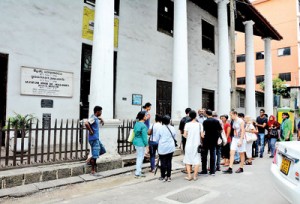
On arriving to Reclamation Road, Dr. De Zoysa gives us a new perspective of the road’s namesake. Previously some inhabitants of the communities that dwelt in the area having engaged in nefarious activities in the past prompted religious leaders to transform the community by erecting religious establishments down the road, in other words “reclaiming” principles and a more orthodox way of life, he tells us.
Passing religious establishments of churches, kovils and the red mosque, the residents of Pettah Dr. De Zoysa adds are “distinct but came together in many ways.”
Our last stop is the Sri Ponnambalawaneswaram Kovil (or the Sivan Kovil) a colossal granite structure constructed in 1915 by
Sir Ponnambalam Ramanathan. Its a calming atmosphere inside the kovil as the granite is cooling beneath the soles of one’s feet and the only source of light coming from the oil lamps.
The sounds of prayers being chanting and the hollow vibrations of instruments like the drums and gong echo throughout the building. Dr. De Zoysa imparts more of his knowledge to us as he describes the parallels of religions, and enacting the tales of the Gods in the temple.
The day was drawing to a close, with the walk ending promptly just 15 minutes past the set time of 6.30 pm.
Three to 5 members of the group went on to see the Wolvendaal Church that was established around 1757. The Wolvendaal church is a symbolic place for any Dutch decedent who is living in Sri Lanka.
GIZ also handles projects that focus on Memory Culture . Parallel to the Pettah Diversity Walks GIZ has also had five Memory Walks guided by Dr. Malathi de Alwis that covered themes such as Histories of Violence and Capitalisation, Histories of Struggle and Protest and Histories of Mourning and Memorialisation. GIZ chose Pettah as it is an area of much diversity. In their next phases they hope to include other areas of interest like Kotahena, Hulfsdorf as well as thematic walks such as the history of printing, in the Colombo area.
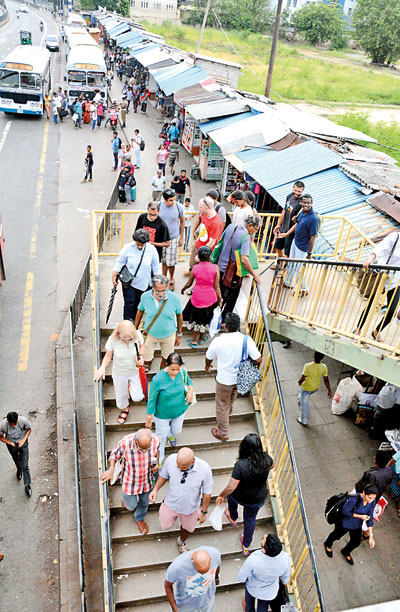
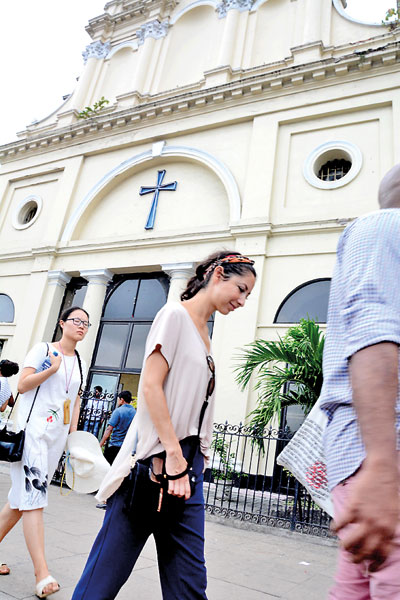
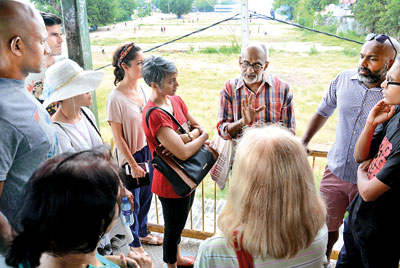
Dr. De Zoysa explaining a point during the walking tour. Pix by Indika Handuwala


